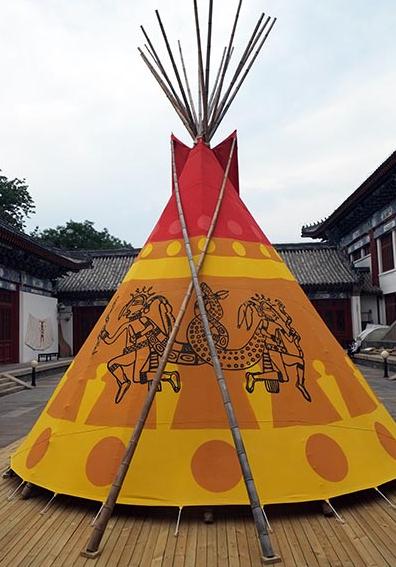
Toni Scott's installation Tepee, featuring totems of Native American tribes, is to celebrate the cultural richness of the tribes.(Photo by Xu Bocheng/For China Daily)
Scott's exhibition is the third staged under the Dame Jillian Sackler International Artists Exhibition Program. It was established in 2013 by Jillian Sackler, widow of Arthur M. Sackler (1913-87), the US physician, medicine publisher and collector. Sackler masterminded and sponsored the museum's construction.
Every year, the program brings an artist's solo exhibition related to history, society and culture.
"The program is of educational importance," Jillian Sackler, who presides over the AMS Foundation for the Arts, Sciences and Humanities, tells China Daily.
"It tries to bring very important issues to the contemporary art world. And hopefully the Chinese students can have something meaningful to see, to learn, to disagree or to have some stimulation. I'm not sure how much the viewers, many being students and small children, really know about slavery ... But seeing something visually can have more of an impact than just reading in a book, which one can't quite relate to."
During a trip in China in the early 1980s, Arthur Sackler first expressed an intention to build a museum at a Chinese university like the one he endowed at Harvard.
"He was incredibly interested in art, museums and education. He had made a lot of different collections, ranging from European paintings, American paintings to Native American art. But his largest collection was the Chinese art, which formed the foundation of the Arthur M. Sackler Gallery in Washington DC," Jillian Sackler says.
She pushed forward the museum's completion following her husband's death, shortly after the groundwork was laid at Peking University.
"I felt the museum was, as Arthur said, a bridge between peoples. It was an educational contribution. I wanted to complete it because I knew my husband wanted to."
The museum is designed in a Chinese garden-style befitting Peking University's campus. It has been a retreat for scholars of archaeology and museology, since its official opening in 1993. It hopes to attract more ordinary visitors with dynamic exhibitions.
If you go
9 am-4:30 pm, through Sept 27. Arthur M. Sackler Museum of Art and Archaeology, near the west gate of Peking University, Haidian district, Beijing. 010-6275-9784.
















































